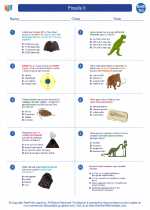Fossils II -> organs
Organs in Earth Science
Explanation
In Earth Science, the term "organs" typically refers to the various parts of the Earth system that work together to perform specific functions. These organs include the atmosphere, hydrosphere, lithosphere, and biosphere. Each of these organs interacts with one another to support life and maintain the balance of the Earth's systems.
Atmosphere
The atmosphere is the layer of gases that surround the Earth. It is responsible for regulating the Earth's temperature, protecting it from harmful radiation, and providing the air we breathe.
Hydrosphere
The hydrosphere includes all the water on Earth, including oceans, lakes, rivers, and groundwater. It plays a crucial role in regulating the Earth's climate, supporting life, and shaping the planet's surface through erosion and deposition.
Lithosphere
The lithosphere is the rigid outer layer of the Earth, including the crust and upper mantle. It provides the physical foundation for the biosphere and interacts with the other Earth systems through processes like plate tectonics and rock formation.
Biosphere
The biosphere encompasses all living organisms on Earth and their interactions with the other Earth systems. It includes ecosystems, food chains, and the impact of living organisms on the Earth's surface and atmosphere.
Study Guide
- Define the atmosphere and describe its functions in the Earth system.
- Explain the role of the hydrosphere in shaping the Earth's surface and supporting life.
- Discuss the interactions between the lithosphere and other Earth systems, such as the atmosphere and hydrosphere.
- Describe the concept of the biosphere and its significance in Earth Science.
- Provide examples of how the organs of the Earth system interact and depend on one another.



